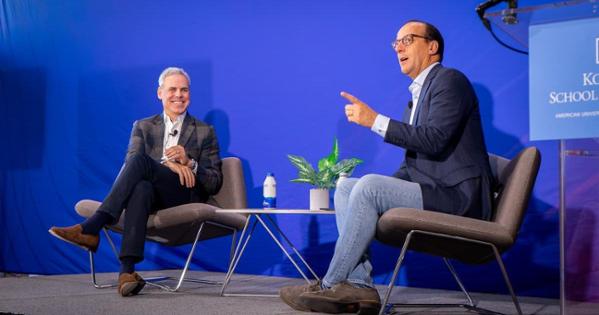Hummus, Falafel, and the Unlikely Rise of Cava

With eight locations in DC and more than 300 across the US—and plans for another 700 by 2032—Cava, the largest chain of Mediterranean restaurants in the country, has taken a huge bite out of the market share.
“We want to be the leader in Mediterranean,” CEO Brett Schulman told an audience of mostly students at the Kogod School of Business on February 14. “When you think of Mediterranean, we want you to think of Cava.”
During an hourlong conversation with Kogod dean David Marchick as part of the school’s Alan Meltzer CEO Speaker Series, Schulman said that while Cava has expanded to big cities and small towns—from Bryant Park in Manhattan to Birmingham, Alabama—its ascendency was no sure thing.
The chain grew out of Cava Mezze, a full-service restaurant opened in 2006 in a half-empty shopping center in Rockville, Maryland, by three sons of Greek immigrants. The childhood friends launched the eatery by maxing out their credit cards and taking out a bank loan that was later withdrawn during the financial crisis. Despite early obstacles, Cava Mezze quickly developed a loyal following of patrons drawn to its good food and great service—tenets that are still central to the company, Schulman said.
“We’re in the hospitality business,” he said. “We believe that our food is amazing. But it’s a heck of a lot better when we’re able to deliver that hospitality.”
A native Washingtonian, Schulman joined the business as a consultant in 2009; soon after, he became a partner and CEO. In January 2011, the foursome secured enough capital to open the first Cava location in Bethesda, Maryland.
Known for its customized bowls and pita sandwiches, Cava had expanded to roughly 60 locations by 2018 when it acquired Texas-based Zoës Kitchen—a struggling competitor with three times as many restaurants and almost twice as much revenue—for $300 million. Marchick likened the move to “a minnow swallowing a whale,” but it opened Cava up to a whole new part of the country. By January 2020, the former Zoës Kitchen locations began turning profit for the first time since 2017, Schulman said.
And then Covid hit. While the pandemic temporarily or permanently shuttered nearly one in six US eateries, according to the National Restaurant Association, Cava made it through the public health crisis relatively unscathed by remaining “pragmatic and realistic.”
“It was rewarding and challenging all at the same time to be able to help guide our collective through a really tough time,” Schulman said.
Today, Cava—which made its public debut on the New York Stock Exchange in June 2023 under ticker symbol CAVA—is poised for even more success. The chain’s line of dips, spreads, and dressings are available in more than 200 grocery stores, including Whole Foods, and last year alone, Cava posted $551 million in revenue.
As the company continues to grow, Schulman said Cava’s recipe for success includes having “good people around you. The bigger [we] get, the more I have to manage the business through other people. If you’re a good leader—we tell this to our general managers—you can almost manage yourself out of a job.”
